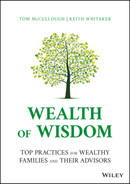SECTION 2
BECOMING A LEARNING FAMILY
Many people think of learning as something that happens only in class (or, maybe, by Zoom) in the context of formal educational programs. One of the most important developments in the field of family wealth in the last decade is the realization that families who succeed over time do not limit their understanding of learning; instead, they make conscious choices to become learning organizations.
Dennis Jaffe starts off this section with a chapter devoted to helping you learn about yourselves as a family, through comparison with global families who have succeeded over time. Jaffe's assessment—which focuses on three areas: Nurturing the Family, Stewarding the Family Enterprise, and Cultivating Human Capital for the Next Generation—reflects his extensive research into family enterprise success factors. It is a simple way to benchmark your family against these global success stories and identify areas where you want to grow and learn.
The next chapter, Jim Grubman's contribution on “Understanding What Wealth Preparation Really Means,” moves us from the macro-level to very specific skills needed to manage financial wealth wisely in a family context. Grubman observes that family members often think they have the requisite skills, without knowing what they don't know. His process connects the roles needed for wealth management with the skills needed to succeed in those roles; it validates the knowledge family members already have while pointing out areas for additional skill development.
Stacy Allred, Joan DiFuria, and Stephen Goldbart then position this work of learning across the developmental stages of an individual life. With their “10x10 Roadmap,” family members can pinpoint which of 10 competencies they want to work on, depending on where they are in a 10-part framework of life stages. This is a tool that provides individuals with direction while also allowing a family to map its members' progress together.
Learning can be a path for connecting what is with what can be. That is the path Bart Parrott leads readers on in the next chapter, in which he lays out a simple but powerful set of questions for families to discuss when facing important choices: What's true now? What's possible? What's our plan? This process of questioning and discovery can apply to choices all the way from the selection of an advisor to momentous decisions about selling a business.
The next two chapters bring the subject of learning back to a more familiar, curricular framework. First, Ruth Steverlynck and Greg Burrows give readers a structure through which to understand how your family could learn best, all the way from identifying the goal of the learning to determining what sorts of platforms or styles best suit family members' learning needs. In the next chapter, Kirby Rosplock offers readers direction in creating their own wealth education plans, to help family members gain specific money skills.
Finally, in a chapter reprinted from the first Wealth of Wisdom volume, Christian Stewart gives readers a plethora of tools to help their families become learning organizations. These tools range from reflective exercises for each individual family member to exercises that allow the family as a whole to chart its future path and understand better the stories that have defined its journey thus far. Stewart also summarizes exercises families can use to promote a “thinking environment” and to manage difficult conversations.
